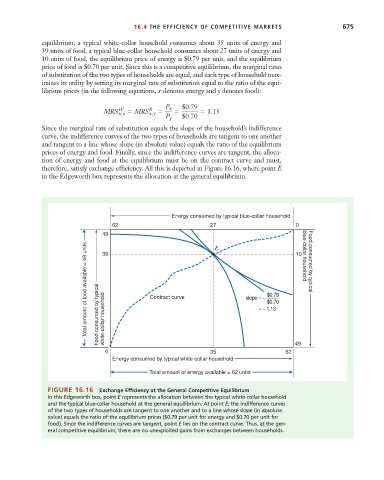Page 701 - Microeconomics, Fourth Edition
P. 701
c16GeneralEquilibriumTheory.qxd 8/16/10 9:14 PM Page 675
16.4 THE EFFICIENCY OF COMPETITIVE MARKETS 675
equilibrium, a typical white-collar household consumes about 35 units of energy and
39 units of food, a typical blue-collar household consumes about 27 units of energy and
10 units of food, the equilibrium price of energy is $0.79 per unit, and the equilibrium
price of food is $0.70 per unit. Since this is a competitive equilibrium, the marginal rates
of substitution of the two types of households are equal, and each type of household max-
imizes its utility by setting its marginal rate of substitution equal to the ratio of the equi-
librium prices (in the following equations, x denotes energy and y denotes food):
P $0.79
W B x
MRS x, y MRS x, y 1.13
P y $0.70
Since the marginal rate of substitution equals the slope of the household’s indifference
curve, the indifference curves of the two types of households are tangent to one another
and tangent to a line whose slope (in absolute value) equals the ratio of the equilibrium
prices of energy and food. Finally, since the indifference curves are tangent, the alloca-
tion of energy and food at the equilibrium must be on the contract curve and must,
therefore, satisfy exchange efficiency. All this is depicted in Figure 16.16, where point E
in the Edgeworth box represents the allocation at the general equilibrium.
Energy consumed by typical blue-collar household
62 27 0
49 E 10 blue-collar household
Total amount of food available = 49 units Food consumed by typical white-collar household Contract curve slope = – $0.79 Food consumed by typical
39
$0.70
= – 1.13
0 35 62 49
Energy consumed by typical white-collar household
Total amount of energy available = 62 units
FIGURE 16.16 Exchange Efficiency at the General Competitive Equilibrium
In this Edgeworth box, point E represents the allocation between the typical white-collar household
and the typical blue-collar household at the general equilibrium. At point E, the indifference curves
of the two types of households are tangent to one another and to a line whose slope (in absolute
value) equals the ratio of the equilibrium prices ($0.79 per unit for energy and $0.70 per unit for
food). Since the indifference curves are tangent, point E lies on the contract curve. Thus, at the gen-
eral competitive equilibrium, there are no unexploited gains from exchanges between households.

